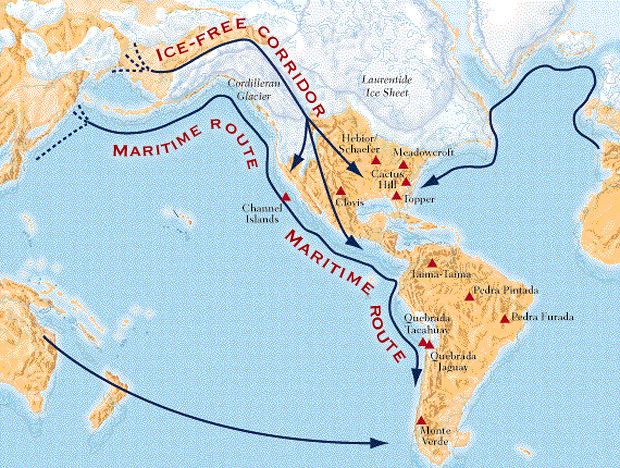
The Misfits and Heroes novels were born out of my belief that humans arrived in the Americas by many different routes at different times. That went against the theory widely taught in school: that the first humans to reach the Americas walked across the land bridge from Russia to Alaska about 13,000 years ago. They followed big game and wandered down an ice-free corridor between mile-high ice sheets. Eventually they populated all of the Americas.
I never doubted that some people arrived that way, but not many. The land simply couldn’t support many.
Then I read about other finds – in Chile, Mexico, Brazil, Texas, South Carolina, Delaware, Florida. They all seemed to predate that ice-free corridor in Alaska and the Yukon. Further, some prominent geologists and paleo-anthropologists claimed the ice-free corridor, if it ever existed, wasn’t passable until 10-12,000 years ago, long after the first settlements in North America. Consider Topper Hill, South Carolina (50,000 years old), Pedra Furada, Brazil (32,000 – 48,000 years old), Monte Verde II, Chile (at least 18,500 years old), Meadowcroft Rock Shelter, Pennsylvania (17,000 years old), and Huaca Prieta, Peru (15,000 years old). Given the antiquity and sophistication of these sites, it seems absurd to hold onto the theory that development and culture moved solely from the north to the south, beginning 13,000 years ago.
But the belief persisted, mainly because it’d been repeated so many times people assumed it had been proven beyond any doubt. At one point, I questioned the whole concept of the “Clovis People” and “Clovis Culture,” since Clovis points were a lithic style, a technological improvement that spread from the southeastern US across North America and down to Venezuela. My argument was that iPhones have spread across the globe, but their presence does not indicate either a “people” or a “culture.” It’s simply a very useful bit of technology. However, my opinion struck a nerve among archaeologists, some of whom claimed they had a bookshelf full of volumes explaining the Clovis people and their culture. So I let it go. But in my heart, I think the Clovis points were a valuable trade item that was held in such high esteem it was included in grave goods. (I’m not sure there’s an equivalent today since technology changes so rapidly. When I started working, really rich people had huge speakers for their component sound system. Today, a system the size of a shoe-box delivers far better sound.)
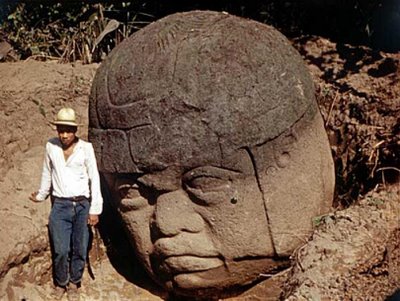
When I visited the Olmec site at La Venta (at least 3500 years old), near Villahermosa, Mexico, I was struck by the amazing sculptures there. Later, in an attempt to drum up interest in my new Latin American Literature class, I took pictures from La Venta into my composition classes at Mott College in Flint, Michigan. Without telling the students anything more than dimensions, materials, and probable age of the pieces, I asked what they thought of them. 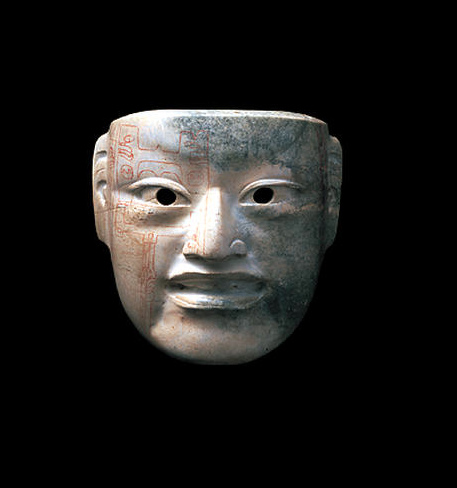
Every group had the same responses: “They’re African” or “They’re Asian.” It was so consistent, it made me wonder. What if African explorers came across the Atlantic to the Americas? What if Asian explorers came across the Pacific? What if they met somewhere – perhaps in the narrow Isthmus of Tehuantepec in southern Mexico, and the fusion of cultures created the fire that forged a brand new civilization?
Those questions (and one more) became the basis of the Misfits and Heroes novels.
West Africa
Misfits and Heroes: West from Africa
The first book in the series, Misfits and Heroes: West from Africa, tells a tale of people forced to learn quickly when their boat is swept out into the open sea. They end up heroes not because they were born with special powers but because they rose to the challenge and made a new life in a new world.
The journey itself has been repeated many times. Katie Spotz rowed a bow across the Atlantic – solo. Axel Busch sailed across the Atlantic – solo – in 21 days. You can watch his video on YouTube https://www.youtube.com/watch?v=VPL35Ul0Ses In 1970, Thor Heyerdahl took Ra II, a reed boat modeled after Egyptian sailing vessels, from Morocco to Barbados, in the Caribbean.
In 2006, English adventurer Anthony Smith put an ad in The Daily Telegraph, reading “Fancy rafting cross the Atlantic? Famous traveler requires three crew Must be OAP (Old Age Pensioners). Serious adventurers only.” Smith, with a bit of whimsy and a nod to Heyerdahl, named his raft the An-tiki. In 2011, the group floated 2,763 miles across the Atlantic, surviving storms and a lost rudder, and ending up on St. Martin, in the Caribbean. Smith did exactly what he wanted to do – replicate the journey of two British seamen who survived drifting for 70 days in a lifeboat after their ship was sunk by a German warship in 1940.
Clearly, all these people were able to cross the Atlantic from West Africa because the current and winds were in their favor. Why then wouldn’t it be possible for ancient people to make the same journey, carried by the same currents? Long-standing prejudice held that ancient people couldn’t take boats across open water, but new evidence shows that our cousins, the Neanderthals, did exactly that, crossing the Mediterranean Sea as early as 175,000 years ago.
Misfits and Heroes: West from Africa – Click on the picture for the Amazon link.
The South Pacific
The second book in the series, Past the Last Island, takes an even bigger leap: it says that the great navigators of the South Pacific found their way across the Pacific Ocean to the Americas in ancient times – not by going all the way north and following the coast down North America, but by traversing open water. The boat in the illustration is Polynesian.
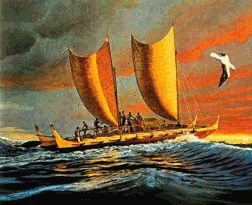
Clearly their ancestors learned to use boats early on. Homo Floresiensis, or The Hobbit People as they’re known because of their short stature, occupied an island on the far eastern edge of what is now Indonesia between 50,000 and 190,000 years ago. Getting there required crossing deep ocean water.
For island people, water was the road, the connection, the wide world. They had to learn how to use it.
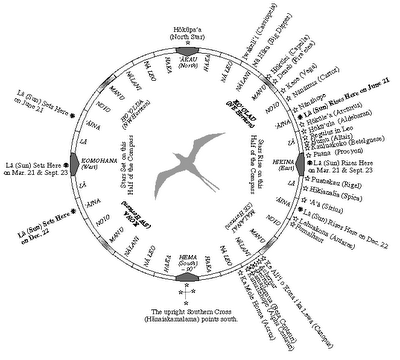
The area encompassing Southeast Asia, Indonesia, Australia, New Guinea, Melanesia, and Polynesia would have been a melting pot of peoples and cultures, in which sea prowess would have played an important role in identifying leaders. The person who could use the wind and waves to travel was admirable. The voyager who could find a way back, even at night, was probably worth elevating to the status of leader. Knowledge was power. A Polynesian star compass is pictured.
Even after Europeans colonized the South Pacific islands and forced people to stay put, native knowledge of the winds, stars, and currents was passed on, sometimes in secret. When a famous European sailor agreed to sail hundred of miles with native Polynesian navigators, the European was so worried he brought his sextants and charts with him and hid them, but he never needed to use them. Despite the European characterization of the people as “primitives,” their knowledge of the sea astounded seasoned European sailors.
It’s now clear that South Pacific seafarers reached Hawaii (possibly following migrating flocks of golden plovers) and Rapa Nui (Easter Island) long before European sailors even knew the places existed. Recent studies of sweet potato DNA suggest trade existed between Polynesia and South America long before the conquistadors arrived.
 Ancient Polynesian DNA retrieved from some Botocudo skulls in a Brazilian museum seems to indicate the presence of Polynesians in Brazil long before the 13,000 BP land bridge was supposed to have opened up in Alaska. (Drawings of Botocudo man shown)
Ancient Polynesian DNA retrieved from some Botocudo skulls in a Brazilian museum seems to indicate the presence of Polynesians in Brazil long before the 13,000 BP land bridge was supposed to have opened up in Alaska. (Drawings of Botocudo man shown)
In 2015, Harvard geneticist Pontus Skoglund discovered DNA links between Amazon Indians and the indigenous peoples of Australia and New Guinea.
The site at Monte Verde, in southern Chile, supports this claim. Despite ferocious resistance from American archaeologists, the site is now recognized as being at least 18,500 years old. Further, finds at the site suggest that the settlement was one of several that enjoyed a trade network. So, how did people get to southern Chile? Either they went all the way down the coast from Alaska, a very long journey, or they came across the southern Pacific.
As with the first book, I’m suggesting that some people would purposely seek out the unknown. Perhaps they were outcasts, thrown out of their villages and left to survive if they could. Many probably died, but some didn’t. Or perhaps, just like modern people, some simply wanted to know what lay beyond the edge of the world.
Past the Last Island – Click on the picture for the Amazon link.
The Merger of Asian and African
The third book takes the biggest risk of all – suggesting a merger of the two groups. But that seems to be what happens when different groups of people occupy the same area. For many years, scientists claimed it wasn’t possible for Neanderthals and modern humans to mate, but most of us carry Neanderthal DNA, so clearly, they could and did mate. And they probably learned a great deal from each other.
If a small group arrived in the Americas and started a settlement, they’d eventually fail unless they found new blood to add to the tribe. I’m guessing that a group of 12 or 15 people couldn’t thrive. In that case, a stranger would be both a threat and a promise. A Meeting of Clans shows both responses.
Complicating this story is the presence of yet another group – outcasts who have become so violent they understand nothing else.
A Meeting of Clans
The Outsiders
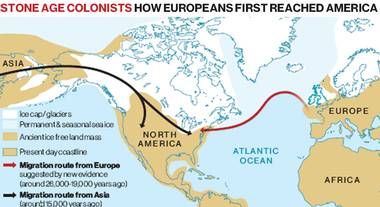
The fourth book grew out of a strange theme in Mesoamerican and South American art – the bearded stranger who looks nothing like the others in the group. Yet he (and it’s usually a male) is clearly in a position of authority. So I combined this idea with part of the Solutrean Hypothesis put forth by Dennis Stanford of the Smithsonian Institution and Bruce Bradley of the University of Exeter. Their theory suggests that humans from what is now northern Spain and southern France reached the Americas and brought several technological innovations with them, including the dart thrower (atlatl – illustrated below), eyed needles, and a thin, bi-faced point that supporters claim became the inspiration for the famous Clovis points that spread across North America.
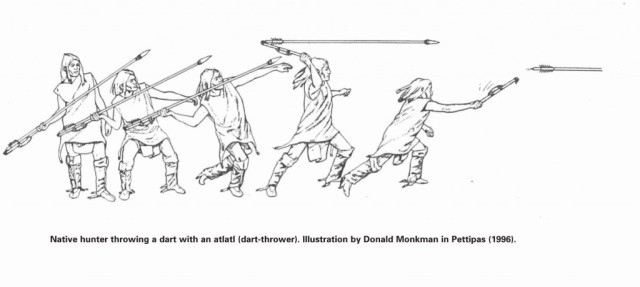
As you would expect, detractors abound. Many complain about Stanford’s proposed route, which went north from Europe, skirted the ice and ended up in northern North America. Since most of the very promising sites on the eastern coast of North America are in the south, I agree that the ice route is unlikely. However, the idea of people crossing from northern Spain to the Americas is still very possible. For one thing, the vast majority of the Clovis-style points have been found in the southeastern US.
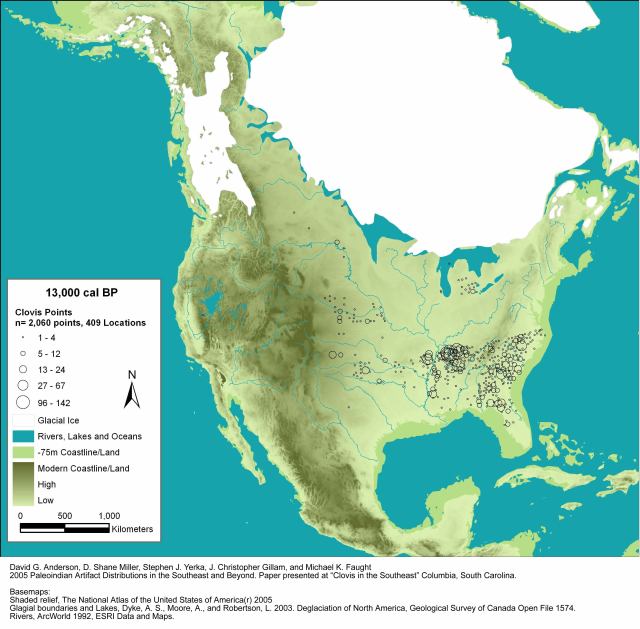
If the originators came from Asia, the majority should have been in the northwest. For another, the travelers in my book would be following approximately the same route Columbus did, except a whole lot earlier! It seems fitting somehow.
So the theory is a wild one, but it’s the basis of the newest book in the series. And the hero is truly a misfit!
A Family of Strangers
The Misfits and Heroes series
All the books are the children of controversy. And that’s fine, at least with me. They’re fiction. They’re meant to open up new ideas for the reader’s consideration. For too long we’ve repeated a story about everyone coming to the Americas across the Land Bridge from Asia about 13,000 years ago. But with so much evidence to the contrary, we can no longer cling to that tale. So the books present another possibility.
Much of what we thought we knew is changing. New studies suggest modern humans may have arisen as far back as 300,000 years ago, perhaps in more than one place. The story of human origins seems to have a great many subplots.
In the next ten or twenty years, the dates of very early settlements in the Americas will probably keep leaping backward as new finds surface.
If you haven’t already read the books, I hope you’ll check them out on Amazon or other on-line sellers or ask your local bookseller to get them. Whether or not you subscribe to any of these theories, you can enjoy the books. They’re just good stories, full of human drama and adventure. If you like them, tell others or leave a review – or both. And thanks to those who have!
Sources and interesting reading:
Many of these topics are also covered in earlier posts on this blog, and sources are listed for each.
“Anthony Smith (explorer)” Wikipedia, htps://en.wikipedia.org/wiki/Anthony_Smith_(explorer)
Axel Busch sail across the Atlantic video, You Tube, https://www.youtube.com/watch?v=VPL35Ul0Ses
Botkin-Kowacki, Eva. “A final blow to myth of how people arrived in the Americas,” Christian Science Monitor, 10 August 2016, https://www.csmonitor.com/Science/2016/0810/A-final-blow-to-myth-of-how-people-arrived-in-the-Americas
Bower, Bruce. “People may have lived in Brazil more than 20,000 years ago,” Science News, 5 September 2017, https://www.sciencenews.org/blog/science-ticker-stone/stone-age-people-brazil-20000-years-ago?utm_content=buffer8976dd&utm_medium=social&utm_sour…
Doucleff, Michaeleen. “How the sweet potato crossed the Pacific way before the Europeans did,” NPR, Food, History, and Culture, 22 January 2013, http://www.npr.org/sections/thesalt/2013/01/22/16998044/how-the-sweet-potato-crossed-the-pacific-before-columbus
Gannon, Megan. “Study: The First Americans Didn’t Arrive by the Bering Land Bridge,” Mental Floss, 10 August 2016, http://mentalfloss.com/article/84506/first-americans-didnt-arrive-bering-land-bridge-study-says
Hawks, John. “Did humans approach the southern tip of South America more than 18,000 years ago?” John Hawks blog, http://johnhawks.net/weblog/reviews/archaeology/america/dillehay-monte-verde-2015.html
“Homo Floresiensis” Wikipedia. https://en.wikipedia.org/wiki/Homo_floresiensis
Hilleary, Cecily. “Native Americans Call for Rethink of Bering Strait Theory,” VOA news, 19 June 2017, https://www.voanews.com/a/native-americans-call-rethink-of-bering-strait-theory/3901792.html
“New Evidence Puts Man in North America 50,000 Years Ago,” Science Daily, 18 November 2004, https://www.sciencedaily.com/releases/2004/11/041118104010.htm
Perkins, Sid. “DNA study links indigenous Brazilians to Polynesians: Sequences shared by far-away populations stir up a Palaeoamerican mystery,” Nature, 01 April 2013. http:///www.nature.com/news/dna-study-links-indigenous-brazilians-to-polynesians-1.12710
Pringle, Heather. “Primitive Humans Conquered Sea, Surprising Finds Suggest: Prehistoric axes found on a Greek island suggest that seafaring existed in the Mediterranean more than a hundred thousand years earlier than thought,” National Geographic, 17 February 2010, http://news.nationalgeographic.com/news/2010/02/100217-crete-primitive-humans-mariners-seafarers-mediterranean-sea/
“Solutrean Hypothesis,” Wikipedia, https://en.wikipedia.org/wiki/Solutrean_hypothesis
Vialou, Denis, Mohammed Benabdelbadi, James Feathers, Michel Fontugne, “Peopling South America’s center: the late Pleistocene site of Santa Elina, Antiquity, 08 August 2017, https://www.cambridge.org/core/journals/antiquity/article/peopling-south-americas-centre-the-late-pleistocene-site-of-santa-elina/04FF561EBC1883B6…
Yirka, Bob. “Evidence suggests Neanderthals took to boats before modern humans,” Phys.org 1 March 2012, https://phys.org/news/2012-03-evidence-neanderthals-boats-modern-humans.html
Wade, Lizzie. “Traces of some of South America’s earliest people found under ancient dirt pyramid,” Science, 24 May 2017, http://www.sciencemag.org/news/2017/traces-some-south-amercias-s-earliest-people-found-under-ancient-dirt-pyramid